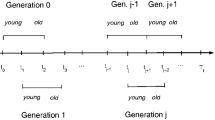Abstract
We study the occurrence of shocks in a common groundwater resource problem using a differential game. In particular, we use Rubio and Casino’s adaptation of the Gisser and Sánchez model where we introduce a sudden change in the dynamics of the resource, namely a decrease in the recharge rate of the aquifer. We compare the pareto optimal solution with open-loop and feedback equilibria. First, we show analytically how different solutions, at the steady state, depend on the intensity of the shock. Moreover, we show that the cost and the strategic effects are decreasing functions of the intensity of the shock, i.e. that all the solutions get closer at the steady state for more intense shocks. We finally apply the game to the particular case of the Western La Mancha aquifer. The aim of this application is to estimate how shocks influence the inefficiency of open loop and feedback strategies in terms of welfare. We show that this inefficiency decreases the earlier the shock occurs or the higher the intensity of the shock.





Similar content being viewed by others
Notes
On the other hand, we call non-adaptation behaviour, when farmers do not have information about the shock until it happens and then change their extraction decisions just from the date of occurrence.
In Rubio and Casino (2001), the storage capacity of the aquifer corresponds to the expression G/H, where G is the volume of water and H is the water-table height of the aquifer.
We remind that inefficiency in terms of welfare is defined as the difference between gains obtained from the pareto optimal solution and the different private equilibria over the whole time horizon.
This choice is motivated by the fact that the decrease of the water-table obtained in \(t_a=20\) can be compared to the estimated drop of 3000 Mm\(^3\) over the last 30 years reported by López-Gunn.
This does not mean that there is an optimal time in order to implement policy instruments. Policy measures should be implemented over the whole planning horizon, as shown in Proposition 4, in order to reach the PO path.
These numbers are obtained by deducting total extractions before \(t_a\) for a shock of 210 Mm\(^3\)/year and a shock of 70 Mm\(^3\)/year, more specifically, by computing the differences 9757 − 9672, 8810 − 8383 and 6474 − 6044 for the feedback, open loop and respectively, pareto optimal solutions.
We thank an anonymous referee for indicating this possibility.
Solution of \(D_3\) is not detailed here, but they are available from authors request.
We remind that in this type of problem with a finite horizon planning, the value function has to be described as a function that depends on G and t independently.
We find that the expression \(\phi (ta,G_{ta})\) does not have the independent term \(t_a\). In what follows, we write the scrap value function, \(\phi (G_{ta})\).
We do not detail expression of \(\epsilon \) because it is not necessary for the resolution of the problem, but it is available from the authors upon request
We do not provide detailed solutions of \(B_i\)\((i=1 \ldots 3)\) because the equations are too long and they are not necessary for the proofs, however, they are available from the authors upon request.
References
de Frutos Cachorro J, Erdlenbruch K, Tidball M (2014) Optimal adaptation strategies to face shocks on groundwater resources. J Econ Dyn Control 40:134–153
Esteban E, Albiac J (2011) Groundwater and ecosystems damages: questioning the Gisser–Sánchez effect. Ecol Econ 70:2062–2069
Esteban E, Dinar A (2012) Groundwater-dependent ecosystems: how does the type if ecosystem affect the optimal management strategy. Working paper
Gisser M, Sánchez DA (1980) Competition versus optimal control in groundwater pumping. Water Resour Res 16(4):638–642
Koundouri P (2004) Current issues in the economics of groundwater resource management. J Econ Surv 18(5):703–740
López-Gunn E (2012) Groundwater governance and social capital. Geoforum 43:1140–1151
López Sanz G (1993) El acuífero 23 de la Mancha Occidental y el acuífero 24 del Campo de Montiel: Funcionamiento, Gestión, problemática y alternativas. Paper presented at the symposium on water management in Campo de Montiel and Western La Mancha, Alcázar de San Juan (Ciudad Real), 13 November 1993
Negri DH (1989) The common property aquifer as a differential game. Water Resour Res 25(1):9–15
Nieswiadomy M (1988) Input substitution in irrigated agriculture in the high plains of texas 1970–80. West J Agric Econ 13:63–70
Olcina Cantos J (2001) Tipología de sequías en España. Ería 56:201–227
Provencher B, Burt O (1993) The externalities associated with the common property exploitation of groundwater. J Environ Econ Manag 24:139–158
Rubio SJ, Casino B (2001) Competitive versus efficient extraction of a common property resource: the groundwater case. J Econ Dyn Control 25:1117–1137
Rubio SJ, Casino B (2003) Strategic behavior and efficiency in the common property extraction of groundwater. Environ Resour Econ 26:73–87
Tsur Y, Zemel A (2004) Endangered aquifers: groundwater management under threats of catastrophic events. Water Resour Res 40:1–10
Tsur Y, Zemel A (2014) Dynamic and stochastic analysis of environmental and natural resources. In: Fischer MM, Nijkamp P (eds) Handbook of regional science. Springer, Berlin, pp 929–949
Acknowledgements
This work was supported by the ANR GREEN-Econ research project (ANR-16-CE03-0005).
Author information
Authors and Affiliations
Corresponding author
Rights and permissions
About this article
Cite this article
de Frutos Cachorro, J., Erdlenbruch, K. & Tidball, M. Sharing a Groundwater Resource in a Context of Regime Shifts. Environ Resource Econ 72, 913–940 (2019). https://doi.org/10.1007/s10640-018-0233-0
Accepted:
Published:
Issue Date:
DOI: https://doi.org/10.1007/s10640-018-0233-0



